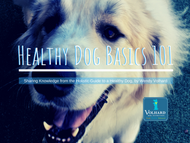Let's Talk about Protein | Healthy Dog Basics 101
Posted by Danae Apel on Jun 11th 2020
Let’s talk about Protein
-The Ingredients of Dog Food-
(Adapted from chapter 2, pg. 5-7, of The Holistic Guide for a Healthy Dog, 1st Edition by Wendy Volhard)
There are six key building blocks for a proper nutritional foundation, let’s discuss number one - Protein
An unfortunate truth in today’s dog community is that the average dog owner doesn’t know what is in their pup’s food. It seems as if large corporations spend more money on marketing than quality ingredients. Thus, the decision on what food to feed your dog can get harder to determine, without a closer look that is. If you scan the shelves of any pet food store, you will find a wide variety of ingredients promising to be the best for your dog. We’re going to take a closer look at one of the most important macronutrients - protein. But before we do that, what are dogs designed to eat?
By looking at the taxonomy of canines, we know that dogs are carnivores. This can be seen in taking a  closer look at their biology, more specifically their jaws. A quick scan of your dog’s teeth will show that they have very defined, sharp canine teeth and pointy back teeth. This is intended by nature to enable them to rip and tear meat. They do not have any flat, wide molars for grinding and are not capable of sideways movement in the jaw, similar to that of a cow. The dog’s short digestive tract and simple stomach are also ideal for digesting meat.
closer look at their biology, more specifically their jaws. A quick scan of your dog’s teeth will show that they have very defined, sharp canine teeth and pointy back teeth. This is intended by nature to enable them to rip and tear meat. They do not have any flat, wide molars for grinding and are not capable of sideways movement in the jaw, similar to that of a cow. The dog’s short digestive tract and simple stomach are also ideal for digesting meat.
Protein - Amino Acids
Now, let’s go back to protein. This macronutrient contains amino acids, the building blocks of protein, and they are necessary to live! Of the 22 amino acids, 10 of them are essential to canines and cannot be produced internally; they must be consumed. If you are feeding a food that contains mostly plant-based protein, it’s highly likely that your dog will be experiencing an animal protein deficiency. This is because plant-based proteins are not as readily digested by the dog’s body as an animal protein is. As a result, this deficiency can manifest in the form of the disease in several different ways: skin and chronic ear infections, some forms of cancer, timidity, excessive shedding, gastrointestinal upsets, lack of appetite, and even “spinning” or tail-chasing to name a few. Commercial dog foods utilize a combination of different proteins (both plant and animal sources) such as meat by-products, chicken, milk, corn, wheat, rice, and soy to name a few. This is what is listed as crude protein. During the manufacturing process of commercial pet foods, they are heated to very high temperatures. This causes an alteration of the amino acids, thus affecting their bioavailability to the dog’s body. If most of the crude protein comes from plant sources, combined with the high temperatures, the dog can become deficient in amino acids.
“Since amino acids are dependent on one another, a diet that contains too little of one will have a chain-reaction effect on the others and will reduce their utilization.” (pg. 6)
You may be able to spot some signs of amino acid deficiency in your pup. Symptoms could include licking or biting at their feet, brittle toenails, or crooked whiskers.
As we have seen, protein is a key nutrient for any dog. The source of that protein also affects the ability of the dog’s body to properly utilize the amino acids contained within the food. Animal proteins are the best source to obtain all the 10 essential amino acids required by dogs. Volhard Dog Nutrition diets offer the flexibility to give your dog a variety of proteins; you choose the protein source. The dehydrated foundation mix combined with your desired protein will create a fresh, healthy, balanced diet for your pup!



